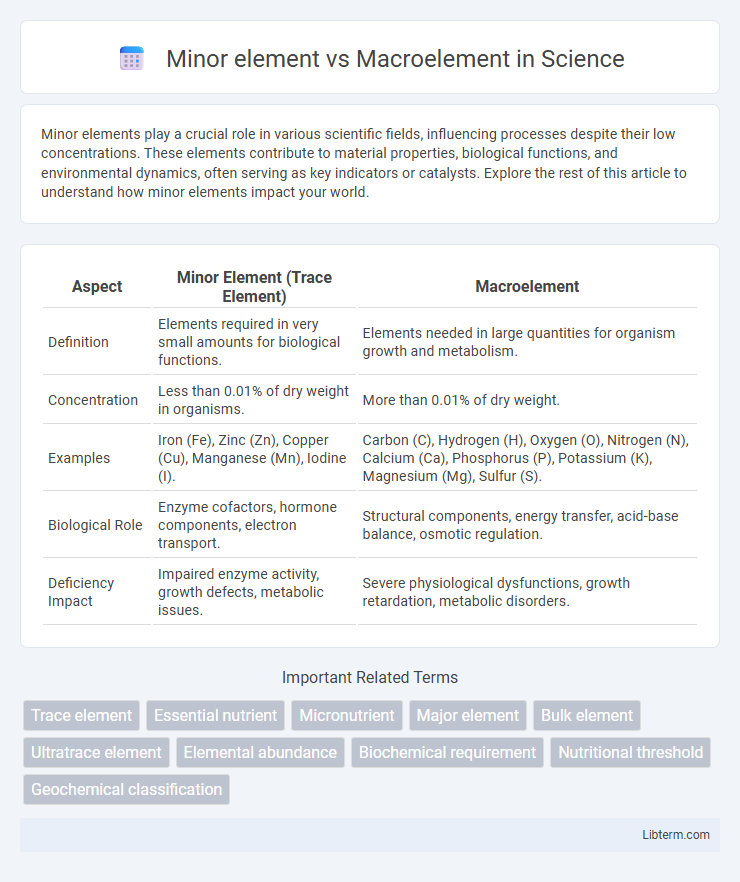Minor elements play a crucial role in various scientific fields, influencing processes despite their low concentrations. These elements contribute to material properties, biological functions, and environmental dynamics, often serving as key indicators or catalysts. Explore the rest of this article to understand how minor elements impact your world.
Table of Comparison
| Aspect | Minor Element (Trace Element) | Macroelement |
|---|---|---|
| Definition | Elements required in very small amounts for biological functions. | Elements needed in large quantities for organism growth and metabolism. |
| Concentration | Less than 0.01% of dry weight in organisms. | More than 0.01% of dry weight. |
| Examples | Iron (Fe), Zinc (Zn), Copper (Cu), Manganese (Mn), Iodine (I). | Carbon (C), Hydrogen (H), Oxygen (O), Nitrogen (N), Calcium (Ca), Phosphorus (P), Potassium (K), Magnesium (Mg), Sulfur (S). |
| Biological Role | Enzyme cofactors, hormone components, electron transport. | Structural components, energy transfer, acid-base balance, osmotic regulation. |
| Deficiency Impact | Impaired enzyme activity, growth defects, metabolic issues. | Severe physiological dysfunctions, growth retardation, metabolic disorders. |
Introduction to Minor Elements and Macroelements
Macroelements, essential nutrients required in large quantities, primarily include nitrogen, phosphorus, and potassium, which support plant growth and development. Minor elements, also known as micronutrients, such as iron, manganese, zinc, copper, molybdenum, boron, and chlorine, are needed in trace amounts but are crucial for specific physiological functions and enzyme activities. Understanding the distinction between macroelements and minor elements is vital for optimizing soil fertility and enhancing agricultural productivity.
Defining Minor Elements
Minor elements, also known as trace elements, are essential nutrients required by plants and animals in very small quantities, typically less than 100 milligrams per kilogram of body weight. These elements include iron, zinc, copper, manganese, and cobalt, playing vital roles in enzyme function, hormone production, and overall metabolic processes. In contrast, macroelements such as nitrogen, phosphorus, and potassium are needed in larger amounts to support structural growth and energy transfer.
Defining Macroelements
Macroelements, also known as macronutrients, are essential nutrients required by organisms in large quantities for vital biological functions, including carbon, hydrogen, oxygen, nitrogen, phosphorus, and sulfur. These elements form the structural components of cells and organic molecules such as proteins, lipids, carbohydrates, and nucleic acids, driving metabolic processes and energy transfer. In contrast, minor elements or trace elements are needed in much smaller amounts but are equally crucial for enzymatic activities and cellular regulation.
Key Differences Between Minor Elements and Macroelements
Macroelements are essential nutrients required by organisms in large quantities, primarily including nitrogen, phosphorus, potassium, calcium, magnesium, and sulfur, which support major physiological functions and structural development. Minor elements, or trace elements such as iron, manganese, zinc, copper, molybdenum, and boron, are needed in much smaller amounts but are crucial for enzyme function, hormone production, and other metabolic processes. The key difference lies in the quantity required and their roles, with macroelements involved in fundamental growth and structural integrity, while minor elements serve as cofactors and catalysts in biochemical reactions.
Biological Roles of Minor Elements
Minor elements, often called trace elements, play critical biological roles despite their low concentrations in organisms, participating in enzyme activation, electron transport, and hormone function. Elements like iron, zinc, copper, and manganese support vital processes such as oxygen transport, immune response, and antioxidant defense. Unlike macroelements, which provide structural components and energy sources, minor elements are essential cofactors in metabolic pathways and cellular regulation.
Biological Functions of Macroelements
Macroelements such as calcium, potassium, and magnesium are vital for maintaining bodily functions including muscle contraction, nerve transmission, and enzyme activation, whereas minor elements primarily serve as cofactors in trace amounts. Calcium regulates blood clotting and bone structure, potassium manages fluid balance and cardiac function, and magnesium supports energy metabolism and protein synthesis. The essential roles of macroelements in physiological processes highlight their significance compared to the limited but critical functions of minor elements.
Sources of Minor Elements and Macroelements
Macroelements such as nitrogen, phosphorus, and potassium are primarily sourced from synthetic fertilizers, organic compost, and mineral deposits, providing essential nutrients in large quantities for plant growth. Minor elements, including iron, manganese, zinc, copper, and molybdenum, are typically derived from trace mineral supplements, soil amendments, and natural rock powders to fulfill plants' micronutrient requirements. Both macroelements and minor elements play critical roles in soil fertility, with their availability influenced by soil pH, organic matter content, and environmental conditions.
Deficiency Symptoms and Excess Effects
Minor elements, also known as trace elements, are crucial nutrients required in small quantities such as iron, zinc, and copper, whose deficiency symptoms include stunted growth, chlorosis, and poor yield. Macro elements like nitrogen, phosphorus, and potassium are needed in larger amounts, with deficiencies causing symptoms like leaf yellowing, necrosis, and weakened root systems. Excess of minor elements can lead to toxicity manifested by leaf burn or inhibited enzyme activity, while excess macroelements may cause nutrient imbalances, reduced absorption of other minerals, and impaired plant development.
Importance in Human Nutrition and Health
Macro elements like calcium, potassium, and magnesium are essential for maintaining bodily functions such as bone health, fluid balance, and muscle contraction, requiring intake in larger quantities. Minor elements, including iron, zinc, and selenium, although needed in smaller amounts, play critical roles in enzyme function, immune response, and antioxidant protection. Deficiencies in either macro elements or minor elements can lead to significant health problems such as anemia, impaired growth, and weakened immunity.
Conclusion: Balancing Minor Elements and Macroelements
Balancing minor elements and macroelements is crucial for optimal plant growth and development, as macroelements like nitrogen, phosphorus, and potassium are required in large quantities, while minor elements such as zinc, copper, and manganese play vital roles in enzymatic functions and physiological processes. Deficiencies or excesses in either category can disrupt nutrient uptake, leading to poor crop yield and quality. Effective nutrient management strategies ensure the right proportional supply of both macroelements and minor elements, promoting sustainable agriculture and healthy plant ecosystems.
Minor element Infographic

 libterm.com
libterm.com